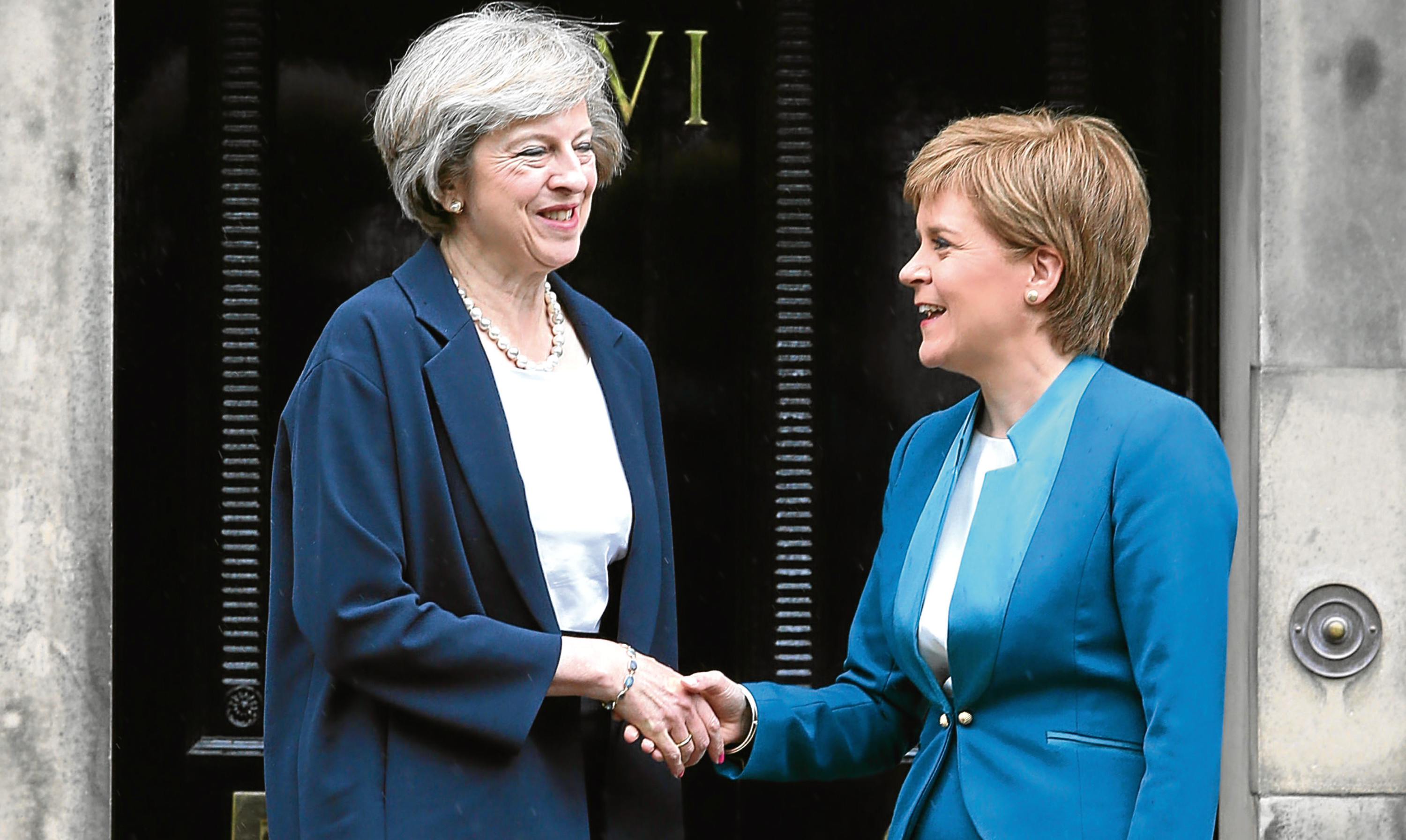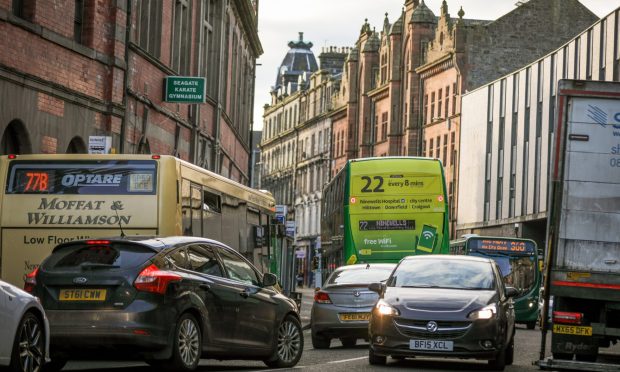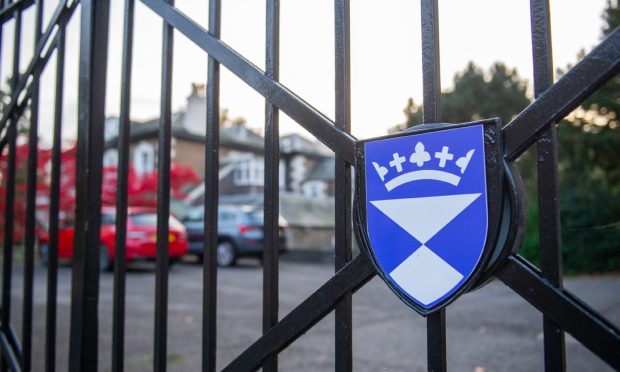The UK Government is preparing for Nicola Sturgeon to demand a second independence referendum is held next August, The Courier has learned.
Theresa May’s team is “war gaming” with the Scotland Office and Ruth Davidson as speculation intensifies that the First Minister will announce her intention to return to the polls at next month’s SNP conference.
The Conservatives say they want to be “calm and collected” if the First Minister declares her intention to stage a rerun of the September 2014 vote.
Multiple sources close to Downing Street have confirmed “contingency” talks are ongoing amid speculation an announcement could be made at the SNP conference next month.

A senior Scottish Tory insider said: “We need to be prepared. Listening to what they (the SNP) have been saying in the past few days the timing could be even faster than August. This is about making sure we are calm and collected ahead of any negotiations.”
Ms Sturgeon has said another referendum is increasingly likely in the wake of the Brexit vote, but she would need UK Government permission for a second legally binding vote.
Sir Michael Fallon, the defence secretary, last week said the SNP should “forget” about holding a second plebiscite, although he appeared to tone down his rhetoric from earlier reports suggesting the UK Government would block a move.
Mrs May’s spokeswoman said in the aftermath of Sir Michael’s comments that the referendum in 2014, when Scotland voted by 55% to 45% to stay in the UK, meant the “issue was settled”.
A figure close to the Downing Street talks said: “The issue which people have got a bit back to front is the Scottish Government can’t call a referendum. We had an agreement last time and would need agreement on issues such as the timing, the franchise and the question again.
“Last time the big issue was whether it was one question or two. This time the timing is one of the things that would have to be agreed.
“We have to reach agreement as we did before. You could argue they have a mandate for a referendum but they don’t have a mandate for a referendum on a specific date.
“Obviously a lot of people have speculated she (Ms Sturgeon) is under a lot of pressure at conference in March but most people don’t want a referendum in the next two years.
“We always have to have contingency arrangements if issues arise.”
A UK Government spokesman said: “The question is not whether there could be a second independence
referendum but whether there should be one – and the answer to that is a clear No.
“The Scottish people are clear they don’t want another divisive referendum and the threat of one is causing
uncertainty for the economy.”
Scottish Government working to protect place in single market
The SNP’s 2016 manifesto explicitly set out the Brexit scenario Scotland finds itself in but Nicola Sturgeon has not yet called a second referendum.
The document stated: “We believe that the Scottish Parliament should have the right to hold another referendum if there is clear and sustained evidence that independence has become the preferred option of a majority of the Scottish people – or if there is a significant and material change in the circumstances that prevailed in 2014, such as Scotland being taken out of the EU against our will.”
Following The Courier’s revelations, a Scottish Government source said: “We remain engaged in a serious effort to protect Scotland’s place in the single market through the compromise proposals we have put on the table. It is up to the UK Government to match that compromise.
“However, it is significant that – contrary to the ill-judged bluster last week from Michael Fallon – the UK Government appear to accept the mandate that clearly exists for a referendum, should that option prove necessary to protect Scotland’s national interests.”
What must happen for an indyref2 to take place
There has to be agreement between the UK and Scottish Governments before a referendum can be held.
The 2014 vote was based on the Edinburgh Agreement, signed by then Prime Minister David Cameron and then First Minister Alex Salmond.
The deal allowed for both governments to bring forward a Section 30 order, giving the referendum a legal base.
Both sides agreed that the referendum should take place before the end of 2014 and “meet the highest standards of fairness, transparency and propriety, informed by consultation and independent expert advice”.
They also agreed to “deliver a fair test and a decisive expression of the views of people in Scotland and a result that everyone will respect”.
Legislation brought before the Scottish Parliament then set out the date, who would be allowed to vote in it, as well as the wording of the question.
For 2014, it was agreed there should be a single question, asking: “Should Scotland be an independent country?”
The Electoral Commission, who changed the question from the SNP’s suggestion last time, has said it wants to look at any new referendum question.
Prominent pro-UK campaigners do not want to rerun the yes or no proposal from 2014 and have called for voters to be asked if they want to leave or remain in the Union, according to The Times.
Nicola Sturgeon’s administration has already drafted legislation for another referendum and put it out to a consultation, which is now closed – but she requires a Section 30 to legitimise any vote.

Beware Tories bearing gifts.
The Courier today breaks the news that background discussions are happening in the Conservative leadership north and south of the Border about another referendum.
Before you get out the Saltire bunting or reach for the Union Jack, pause a while.
Tories feel that whatever they say on the matter, they just seem to irritate
people.
This may be an attempt to find a more inclusive response.
Should the FM tell the forthcoming SNP conference she’s determined to have the vote in 2018, the UK Government can sound intrigued rather than hostile.
They will say – ‘OK, let’s sit down and sort out a new agreement on what Indyref2 will look like.’
That is wholly different to letting Nicola re-run 2014.
The Tories will be looking to get the SNP involved in a discussion which may not go to Nationalist liking.
The referendum question will be debated – the Scottish Government likes the last one “Should Scotland be an independent country?”
Theresa May could change this to – “Should Scotland leave the UK and set up a new currency?” – which is much less appealing.
The UK Government could also elaborate on what the alternative looks like, suggesting a rejection of independence would still mean enhanced powers coming to Holyrood as a by-product from the Brexit process.
The UK Government could make the Scottish Government endorse a single White Paper, setting out both options.
Starting the discussion would force the SNP into specifics on currency,
economy, ability to pay pensions etc – which is where they are weakest.
That said, suggesting another vote is possible and close is a risky strategy.
With polls showing no increase in enthusiasm for indyref2, the Tories
may hope to kill the independence movement off with the appearance of kindness.
That would give Ruth Davidson a far better chance at toppling Nat MSPs come the 2021 Holyrood vote.
But David Cameron gambled on the same policy with Brexit, and lost.
What is more, talk of another vote will irritate Tory unionists.
It would give the Nats a new focus, and there’s no telling what might happen.










